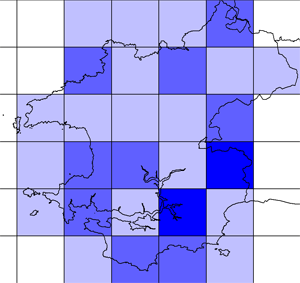Dunnock - 2003-07
 Friday, May 11, 2012 at 9:32PM
Friday, May 11, 2012 at 9:32PM Formerly inhabiting scrub in arctic–alpine areas and woodland in tundra eastward from Poland, it has expanded its range westward to occupy a variety of lowland habitats. In Pembrokeshire it has become widespread, being absent only from the tops of the Preseli Mountains and the smallest offshore islands. Its nests are well concealed in bushes, hedges, trees or on banks.
No great difference is apparent when comparing the results of the two local surveys. The estimate of 22,000 pairs in Pembrokeshire which accompanied the 1984-88 survey was based on an average of 50 pairs per tetrad. This was a lower figure than the 60 pairs per tetrad used in the National Atlas of 1966–72, because an attempt was made to take into account the effects of the severe winter of 1982. The 1988-91 National Atlas used an average density of 44 pairs per tetrad for the UK. Since then the BBS has calculated a 38% increase in Wales between the years 1994 and 2007. Applying this to the original Pembrokeshire estimate suggests that there were 30,000 pairs by the end of 2007. Although this is expressed as pairs, the social life of the Hedge Accentor is such that some territories can be occupied by one female mated to two males or by one male with more than one female. So perhaps the population should be regarded as the number of occupied territories rather than pairs.
Graham Rees

Fieldwork 2003-07 (based on 490 tetrads)
Red = breeding confirmed = 161
Orange = breeding probable = 273
Yellow = breeding possible = 11
Total tetrads in which registered = 445 (90.8%)
 GHR,
GHR,  PBBA 2003-7 in
PBBA 2003-7 in  Dunnock,
Dunnock,  Hedge Sparrow
Hedge Sparrow 




